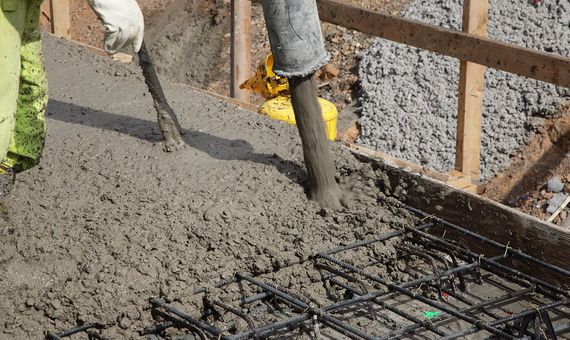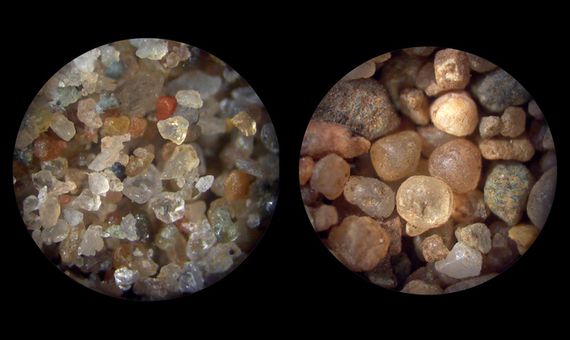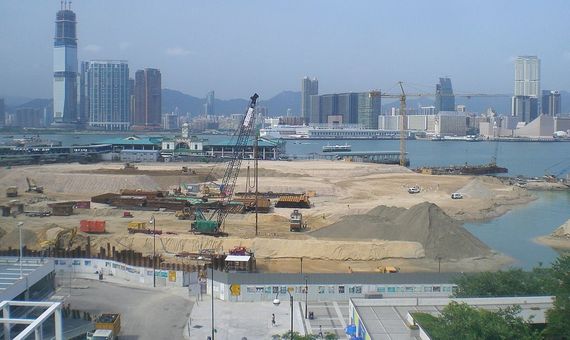Our world is a voracious consumer of sand and gravel, some 50 billion tonnes a year. This is enough to build, every year, a wall 27 metres high and 27 metres wide that would encircle the entire planet at the equator. Spurred by the mistaken belief that it is an unlimited resource, our addiction to sand is destroying natural ecosystems and fuelling organised crime.

What do we use sand for? For just about everything. From the stained glass windows in cathedrals to the lenses in the Hubble Space Telescope, from smartphones to wine glasses, from breast implants to solar panels, sand is ubiquitous in our daily lives and in our technological development. But more than half of all the sand we consume is used to make concrete, the most essential material in buildings and infrastructure, making sand the literal foundation of our global civilization.
With rapid global urbanisation, it is estimated that the world is building the equivalent of eight to ten cities the size of New York each year, leading to a skyrocketing demand for concrete (which is composed of sand and gravel bonded with cement). China alone consumes half of the world’s concrete supply and between 2011 and 2014 used more concrete than the United States did in the entire 20th century. “China is the most voracious consumer of sand in human history,” says Vince Beiser, author of the book The World in a Grain: The Story of Sand and How it Transformed Civilization, in which the investigative journalist reports on the global sand crisis and its dramatic consequences.
Not all sand is created equal
Sand originates mainly from rocks, especially quartz rocks (70% of all sand is quartz), which are continuously eroded by wind or water. However, sand is a non-renewable resource, as the process is extremely slow and much of the resulting sand cannot be used.
Sand formed by water is irregular in shape, so it binds well and makes good concrete, but with one caveat: sea sand contains salt, which if not washed out can corrode metal rebar. Poor quality concrete, contaminated with salt, is believed to have played a role in the collapse of many buildings in the devastating 2010 Haiti earthquake.

Wind erosion creates the kind of sand found in the world’s deserts. Unfortunately, desert sand grains are smooth and do not bond well together, making them unsuitable for concrete—it would be like building a house with marbles instead of bricks. Indeed, the world’s tallest building, the 830-metre Burj Khalifa in Dubai, a city perched on the edge of an endless desert, was built with sand imported from Australia.
Impunity for sand mafias
Sand mining is a multi-billion dollar business and increased demand for sand and rising prices have attracted the interest of organised crime in countries as far afield as India and Italy. According to Beiser, “the demand for sand is so intense in some places that organised criminal gangs have taken over the trade. They have literally murdered hundreds of people in the last few years over sand. ” Some examples of recent sand-related killings include a Mexican environmental activist, a South African sand miner and an Indian journalist.
In India, illegal sand mining is the largest organised criminal activity in the country. Criminal gangs known as “sand mafias” plunder sand and gravel resources with impunity. Their activity generally flies under the radar, even though it generates the same level of corruption and violence as the illegal trade in wild animals.

All over the world, from Jamaica and Indonesia to Sri Lanka, Morocco and Sierra Leone, sand is stolen from beaches, sold to the local construction industry, or shipped to richer countries to replenish their beaches or reclaim land from the sea, as in Singapore, which has expanded its surface area by more than 20% since the 1960s. In Morocco, environmental officials estimate that half the sand used in the construction sector is stolen from local beaches. This black market dilutes the responsibility for washing the sea sand to remove the salt, increasing the likelihood that buildings will have structural problems in the decades to come.
An industry with a high environmental impact
But leaving aside the extreme case of these new mafias, large-scale legal sand mining has numerous environmental effects, often affecting the poorest regions. The largest natural reserves of industrially useful sand are at the bottom of rivers and lakes, or on the sea floor, as well as on beaches and riverbanks. When this sand is removed, everything that lives in the sand is destroyed, including the eggs of fish, turtles and crocodiles, which is an assault on the biodiversity of these aquatic ecosystems. As stated in a 2021 report in the journal One Earth: “Ecosystem degradation associated with [sand] mining threatens species and ecosystems such as wetlands, rivers, coastal dunes, or seagrass meadows.”
Sand dredging operations reject the smaller particles, which are pumped back into the water, increasing turbidity and drastically altering the aquatic habitat, smothering fish and blocking the light essential for algae and corals. On the other hand, removing their heavier sediments (sand and gravel) causes rivers to flow faster and penetrate deeper into the valley floor. This lowers the water table and contaminates drinking water supplies, as well as increasing the frequency of flooding and causing damage to infrastructure such as bridges.

When heavy sediments from rivers stop reaching the sea—due to sand mining and dams—beaches and deltas are no longer replenished and erosion increases. For example, unsustainable levels of sand mining along the Mekong River in Southeast Asia are causing the Mekong Delta, already threatened by rising seas, to shrink by several centimetres a year, further endangering its future.
There are currently no international conventions regulating the extraction, use and trade of sand, and this lack of control is fuelling the black market and all its dreaded effects. According to a report published in Science in 2017, “even when sand mining is regulated, it is often subject to rampant illegal extraction and trade.” Despite being a global problem “with major sociopolitical, economic, and environmental implications,” it has not attracted the attention it deserves. The international community has its head buried in the sand in the face of a crisis that erodes the foundations of our technological civilisation and for which there are no simple solutions.
Comments on this publication